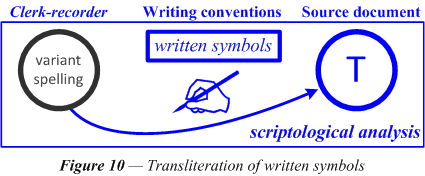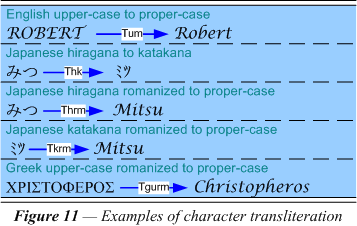
1.3 Transliteration. It has long been a custom to capitalize the first letter of a name. Capitalization is an example of transliteration where the language is not different, but the alphabet used allows two ways of making the same letter. The upper-case and lower-case letters are two very different forms for each character. The terms “upper-case” and “lower-case” come from the relative positions in which typesetters arranged the cases from which the type was taken for setting. The typewriter and derivative computer keyboards allow both letter forms to be typed with the same key, one without and one with the shift-key depressed simultaneously. This makes transliteration susceptible to typographical error.

The clerk as the recorder of a source document intentionally creates a variant spelling by systematically using an alternative writing system or transliteration method in the same or different languages. The clerk as a copiest may also adjust the writing system through transliteration. The clerk as an extractor may also use a method of transliteration in an effort to make the writing of the original more modern or familiar. In case different languages and cultures are involved, there is also adaptation to the phonetic structure of the borrowing language, i.e., there is often a certain amount of respelling. When the two languages use disparate alphabets, the borrowing involves a mapping from letters in one to those in another. As long as for every letter in the first language there is a corresponding letter in the borrowing language there is no problem. Due to the history and origin of English alphabet most of the letters of the Greek alphabet, for example, have more or less equivalent letters in English. However, there are also a few letters in their alphabet that require a two letter combination to express an equivalence, such as θ = th, φ = ph, χ = ch, ψ = ps. And so, when there are multiple letters, it is sometimes difficult to know exactly what the letters correspond to in Greek, unless the person is somewhat conversant in that language.
Transliteration can occur whole within many written languages, as with the case distinction in English. Japanese has various “kana” or writing styles for their language, which, when written, normally represent each syllable with a different character. The earliest style was Kanji, which was based on the Chinese characters. In names the Chinese characters may represent either the sound of the syllable (on), which is usual, or less frequently the meaning of a word (kun).

Hiragana style was one of the syllabaries developed and used usually by women to write their literary productions. A simpler style is Katakana, another syllabary, whose characters are in general simpler to write. The Kanji, Hiragana, and Katakana are sometimes used together to set the context of a name, somewhat like English uses cases. All of these Japanese styles can also be transliterated into English or into any Western language by using a particular method of romanization that represents its pronunciation. In the example in figure 11, the first symbol represents the syllable “mi” and the second, “tsu.” Particular romanizations may be more or less true to the syntactic, morphological, and phonetic structure of Japanese.
The transliteration of Japanese syllabaries to romanized versions involves a table with each Japanese symbol corresponding to multiple alphabetic symbols. Romanization of other alphabets can involve the same sort of one-to-many equivalences. Some of the Greek letters are conventionally transliterated into consonant clusters. The Cyrillic letters of Russian and other East European languages can also have multiple letter equivalents or use diacritics so that multiple romanization systems may be in use. In recent times there is the practice, when romanizing, of making special letter combinations using a ligature. Such new letters avoid some ambiguity at the cost of expanding the Roman alphabet, but in an easy and natural way.
